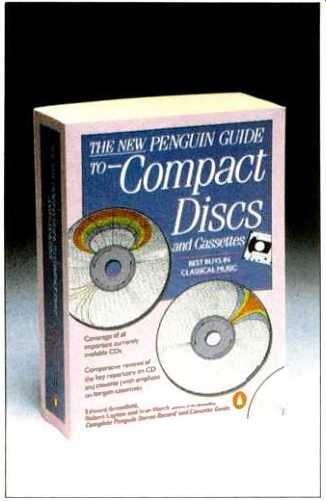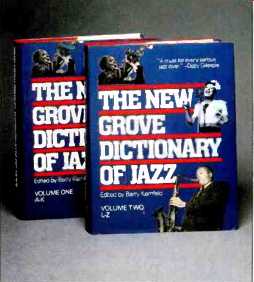REVIEW REVUE

The New Penguin Guide to Compact Discs and Cassettes by Edward Greenfield, Robert Layton, and Ivan March. Penguin, 1,366 pp., softback, $14.95.
The first edition of The Penguin Guide was reviewed in Audio just a little over two years ago. At the time, few could have foreseen the rapid ascendance of the CD and the concomitant "retirement" of the LP, but that's exactly what has happened. The first Penguin Guide reviewed all three formats--CD, LP, and cassette--while the new edition covers only CDs and cassettes. The first also reviewed nearly all CDs available at the time. However, the release rate during the last two years has been so great that the new edition presents "coverage of all important currently available CDs." A visit to your local record outlet will confirm what is happening; the CD bins are taking over, and this medium has breathed new life into a once ailing industry. With a touch of nostalgia, we might all lament the passing of the LP from the scene, but in our more rational moments, we can only rejoice in the fact that surface noise, rumble, and other mechanical defects are practically a thing of the past.
But all may not be well, for we have gone from a shortage of CDs to overabundance in too short a time. A backlash could set in and spell trouble for the smaller labels. Many of the major classical labels have recently adopted a CD--and cassette-only policy, bringing out LPs only in the case of strong crossover items. In this regard, they have followed the lead set by the smaller labels, many of whom dropped the LP much earlier.
The new Penguin Guide follows the same format established by the first edition. It is not much larger in physical size, but a reduction in type size has increased its length by about 40%. The guide is available at most classical record counters. Major listings are by composer, with relatively short final sections dealing with classical collections and recitals. For the most part, the entries are for both CD and cassette; cassette-only entries are primarily for the sake of completeness in listing works of a given composer.
The system of abbreviations is as detailed as it was in the earlier editor.
All items are assumed stereo unless specifically stated as mono. If the catalog number for a release is the same in the United States as in Britain (most labels are moving in this direction), the abbreviation "(id)" is used. Works originally recorded in digital are so indicated. CD catalog numbers are listed in boldface, while cassette numbers are in italics. If it fits into the context of the review, the guide's authors indicate the date a release was recorded. This is of great help when placing the production in historical perspective; I only wish it had been done for every listing.
As in the first edition, authors Greenfield, Layton, and March emphasize musical and performance values, with just enough mention of recording and technical quality to make the guide a useful one for the audiophile. While the quality level of a given CD release is virtually constant anywhere in the world, the same, alas, cannot be said about cassettes. Most of the authors' comments about the quality level of a given cassette release might just as well be taken with a grain of salt, so variable may be the production quality from unit to unit. Improvements are on the way, but for now, there is a long way to go.
The guide is a British work, and as such, gives more emphasis to modern British composers than to American composers or those of any other specific national group. This is no problem since the main thrust of the guide is the standard musical fare which truly belongs to one world. Bear in mind that the major classical companies in the States are now foreign owned and pursue virtually the same paths in repertoire, relying on artists and orchestras of international reputation and acceptance.
Some of the copy in the new guide is taken directly from the earlier one.
There have been relatively few deletions in the worldwide CD catalog, and, of course, a noteworthy release deserves continuing mention. New releases are compared with older ones, and the old text merges smoothly with the new.
For most users, the chief value of the guide will be in selecting from among many versions of a popular work. The authors are, in fact, at their very best in helping the reader make such decisions. They mention the intrinsic merits of a given performance, and present options based on couplings and technical vintage. A reader contemplating, say, a complete set of Bruckner symphonies will probably be led to von Karajan. A collector who may already have one or two of the works will be presented with the merits of several performances of each work, and can thus make an informed decision while minimizing duplication.
Much the same holds for the major composers, whose works are now replicated nearly to the extent they were on LP. As Bert Whyte wrote in the January issue of Audio, there are now 45 CD versions of Vivaldi's "Four Seasons." Mercifully, the authors review only 20 of these, and their reviews are substantially more than passing mention. One clearly gets the message that everything reviewed in the guide has been listened to in its entirety-a monumental accomplishment!
The coverage of opera is especially rich. Because of high production costs, operas are not recorded today with the frequency they were from 1955 to 1970. In those golden days, it was not too difficult to assemble the "dream cast," and many of the productions of John Culshaw for British Decca and Walter Legge for EMI are singled 1 out in the guide for highest praise, whether mono or stereo. One by one, these items are making it onto CD, and the market is the richer for it.
The orchestral side of Wagner's operatic writing, long a favorite of non operatic conductors, is given detailed treatment, again with the listings drawing from early, middle, and recent releases. Solo piano works of Mozart, Schubert, Beethoven, Chopin, and other masters of the instrument are given relatively succinct, to-the-point coverage-a necessity, perhaps, in a book which truly cannot be all things to all readers.
The authors use a rating system, with three stars representing a first-class performance. A special rosette symbol is reserved for performances of landmark status, and there are not many of these. Typical here are many symphonic and orchestral productions dating from the "golden age" referred to earlier. Budget-priced CDs are indicated as well.
The classical record business is not driven by composers but by artists. As new artists come on the scene, their reputations are made with the core of the classical repertoire. Conductors, pianists, and singers all want to draw from a relatively small part of the available literature as they build their personal careers and, almost incidentally, contribute to the coffers of their record companies. Unless a recording is truly remarkable, it merely becomes one more item on an assembly line, and as such, it must recoup its investment in no more than two or three years. The challenge in responsible record reviewing is to identify those recordings which are good enough to last and then to underscore their specific merits. The reviewers in the new Penguin Guide have excelled at this. Avid record collectors would not want to be without Fanfare, American Record Guide, and the British Gramophone, which are the major record review periodicals in the English language. The Penguin Guide is an essential work as well, putting the better part of the thousands of CD titles now available at the reader's fingertips.
Perhaps the highest compliment which a reviewer can give the authors, beyond acknowledging their musical and discographic competence, is to state that they truly have a keen sense of what the art of recording is all about and what goes into making a recording-all of which makes for great reading. Highly recommended!
-John Eargle

The New Grove Dictionary of Jazz, Vols. I and II edited
by Barry Kernfeld.
Grove, 697 pp. and 704 pp., hardbound, $350 plus $10 shipping and handling. (Available from Grove's Dictionaries of Music, Department CH, 15 East 26th St., New York, N.Y. 10010.)
Jazz is over 100 years old, although the first recordings weren't made until 1917 (Original Dixieland Jazz Band). Only in the last 30 or so years have books and reference works on this music proliferated. This massive and scholarly two-volume work is the most important yet, replacing the groundbreaking Encyclopedia of Jazz, first published by Leonard Feather in 1956, and Chilton's valuable Who's Who in Jazz (1970). The Grove Dictionary joins the classic Dictionary of Music & Musicians by George (later, Sir George) Grove, first published in 1890 and now in its sixth edition (1980)-at 20 volumes! Its publishers also offer The New Grove Dictionary of American Music (four volumes, 1986) and The New Grove Dictionary of Musical Instruments.
In addition to making full use of previous reference works (Feather, Chilton, et al.), this latest Grove edition provides an enormous amount of new material. Its 3,000 biographies include composers, arrangers, musicians, producers, impresarios, discographers, critics, and 300 record companies, past and present. Many discographies and bibliographies are also included, to guide interested readers in further research. The work surveys many important theoretical topics, such as improvisation, harmony, beat, and notation, and examines over 200 musical terms specific to jazz as well as instruments used to make sounds heard only in jazz.
Other important areas not covered by previous works but detailed here are musical procedures, structures, and styles unique to jazz. Brief musical examples of improvisations are shown for some of the most important musicians: Armstrong, Basie, Eldridge, Ellington, Gillespie, Hawkins, Monk, Parker, et al.
Movies incorporating jazz are covered, and a valuable 12-page essay on jazz in films by pioneering collector Ernie Smith is included. James Collier contributes a description and history of jazz in an excellent 26-page essay, and composer/conductor Gunther Schuller has written a good piece on Ellington.
The section on jazz festivals describes more than 200 around the world, beginning with Newport 1954.
Nightclubs and similar venues are listed, with almost 1,000 entries, including many historically important though now defunct clubs. Finally, libraries and other archives with collections of jazz books and recordings are listed.
One problem which results when compiling a work such as this from the contributions of over 200 writers from around the world is that several prominent American jazz men and women are omitted while dozens of less important international players are included.
In fact, nearly one-quarter of the biographies deal with non-American musicians, recordings, nightclubs, and festivals! Despite its faults, The New Grove Dictionary of Jazz is worth its high price and now stands as the reference work on the art form. Like previous Grove editions, it should remain so for many years.
-Charles Graham
(adapted from Audio magazine, Jul. 1989)
= = = =